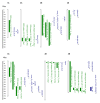Genetic Analysis Using a Multi-Parent Wheat Population Identifies Novel Sources of Septoria Tritici Blotch Resistance
- PMID: 32759792
- PMCID: PMC7465482
- DOI: 10.3390/genes11080887
Genetic Analysis Using a Multi-Parent Wheat Population Identifies Novel Sources of Septoria Tritici Blotch Resistance
Abstract
Zymoseptoria tritici is the causative fungal pathogen of septoria tritici blotch (STB) disease of wheat (Triticum aestivum L.) that continuously threatens wheat crops in Ireland and throughout Europe. Under favorable conditions, STB can cause up to 50% yield losses if left untreated. STB is commonly controlled with fungicides; however, a combination of Z. tritici populations developing fungicide resistance and increased restrictions on fungicide use in the EU has led to farmers relying on fewer active substances. Consequently, this serves to drive the emergence of Z. tritici resistance against the remaining chemistries. In response, the use of resistant wheat varieties provides a more sustainable disease management strategy. However, the number of varieties offering an adequate level of resistance against STB is limited. Therefore, new sources of resistance or improved stacking of existing resistance loci are needed to develop varieties with superior agronomic performance. Here, we identified quantitative trait loci (QTL) for STB resistance in the eight-founder "NIAB Elite MAGIC" winter wheat population. The population was screened for STB response in the field under natural infection for three seasons from 2016 to 2018. Twenty-five QTL associated with STB resistance were identified in total. QTL either co-located with previously reported QTL or represent new loci underpinning STB resistance. The genomic regions identified and the linked genetic markers serve as useful resources for STB resistance breeding, supporting rapid selection of favorable alleles for the breeding of new wheat cultivars with improved STB resistance.
Keywords: MAGIC population; SNP genotyping array; genetic disease resistance; quantitative trait locus (QTL) mapping; r/qtl2; septoria tritici blotch; wheat.
Conflict of interest statement
The authors declare no conflict of interest. The funders had no role in the design of the study; in the collection, analyses, or interpretation of data; in the writing of the manuscript, or in the decision to publish the results.
Figures




References
-
- Cook E. Agriculture, Forestry and Fishery Statistics, 2018 Edition. Publications Office of the European Union; Luxembourg: 2018.
-
- Trnka M., Rötter R.P., Ruiz-Ramos M., Kersebaum K.C., Olesen J.E., Žalud Z., Semenov M.A. Adverse weather conditions for European wheat production will become more frequent with climate change. Nat. Clim. Chang. 2014;4:637–643. doi: 10.1038/nclimate2242. - DOI
-
- Van der Bom F., Magid J., Jensen L.S. Long-term P and K fertilisation strategies and balances affect soil availability indices, crop yield depression risk and N use. Eur. J. Agron. 2017;86:12–23. doi: 10.1016/j.eja.2017.02.006. - DOI
Publication types
MeSH terms
Supplementary concepts
Grants and funding
LinkOut - more resources
Full Text Sources

